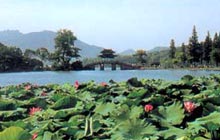
 The Western view:
The Western view:
"Green mountains surround on all sides the still waters of the lake. Pavilions and towers in hues of gold and azure rise here and there. One would say a landscape composed by a painter. Only towards the east, where there are no hills, does the land open out, and there sparkle, like fishes' scales, the bright coloured tiles of a thousand roofs."
(Jacques Gernet, Daily life in China on the Eve of the Mongol Invasion)
The Eastern view:
"In heaven there is Paradise, On earth there are Suzhou and Hangzhou." (popular saying)
Hangzhou's inordinate beauty has been an inspiration to artists for centuries – Lin Hejiang, a tenth century poet is famous for having lived as a recluse on Solitary island for twenty years. And indeed, two more of China's most influential poets, Bai Juyi and Su Dongpo, served as governors here at that time.
During the Qing dynasty (1644-1911) the city became known as a popular tourist destination, much frequented by such notables as the Emperor Kangxi and Emperor Qianlong, who built a palace and important library here. Similarly, during the late twentieth century, Mao Ze Dong was smitten by its charm. He snatched moments from his hectic political life to write "Ode to the Mume Blossom", which by its very title recalls Lin Heijiang's "To the Mume Blossom", written a thousand years earlier.
Hangzhou rose to prominence as the capital of the Southern Song dynasty (1127-1279). Forced to flee before the invading Jurched, the Imperial court under the rule of the pusillanimous Emperor Gaozong (1107-1187) moved its capital southwards from Kaifeng to Hangzhou. Under the patronage of this court, Hangzhou's arts and commerce received unprecedented impetus, transforming it, in Marco Polo's words into, "a city of heaven…the finest and most splendid city in the world."
Chinese products, such as silk and ceramics, were traded for wood, pearls and handicrafts from Japan; ginseng and medicinal herbs from Korea; and spices, ivory and jewels from Southeast Asia and the Middle East. As a result, by the end of the thirteenth century, the wealthy population had swelled from half a million to nearly two million. The city became known for its sybaritic life: one resident had the floor of his house covered with tiles inlaid with silver; pets were dyed pink with balsam leaves and Hangzhou's West Lake became the focus of a thirteenth century pleasure-ground with splendid boats, restaurants and entertainers.
Seven hundred years later, Hangzhou's West Lake continues to draw foreign tourists and local Chinese to its beautiful shores.